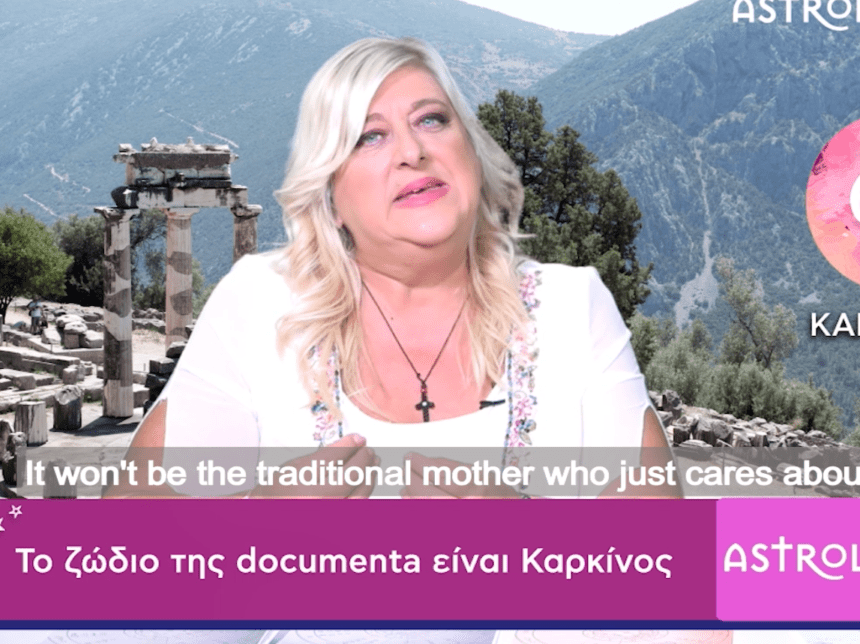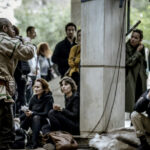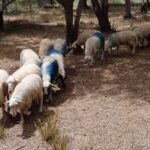Predictions by Bella Kydonaki. Learning from Athens and Learning from documenta
Eleana Yalouri and Fotini Gouseti

Eleana Yalouri
The first time I collaborated with an artist on the topic of foretelling was through a project on predictions of what was yet to come in Greece at a time of national debt and impending bankruptcy [1]. The outcome of that collaboration was a video (The Metaphysics of the Greek Crisis) which took the form of a montage of YouTube extracts, where well-known and unknown people, Greek and non-Greek politicians, economists, priests and preachers, astrologers, a monk and a nun, as well as clairvoyants and chartists predicted Greece’s future [2]. That was an occasion for me to reflect on the topic of prophecy and its ambiguous relationship with other (scientific, rational) forms of knowledge production. But it was also an opportunity to reflect on and realize the importance of the forms and the aesthetics one chooses to employ in delivering the research process and its outcome, especially when this research concerns the unknown, the invisible, the affective and the uncanny. For someone educated in rational analytic academic thought and the priority it gives to textual documentation and grounded argumentation, recognizing that did not come naturally.
The work Predictions by Bella Kydonaki. Learning from Athens and Learning from documenta was a kind of follow-up to that first video. Learning from documenta had proved to be a particularly difficult research project, both emotionally and analytically, and members of the project team, who experienced that difficulty with us, had often jokingly said that we would need the help of an astrologer to find out how and at what cost the Learning from documenta project was likely to evolve. When Fotini Gouseti mentioned the name of an astrologer with whom she had collaborated in the past, we agreed to take the team’s need ‘to consult an astrologer’ literally, and we paid her a visit.
Sitting behind her desk—upon which Orthodox Christian icons rubbed shoulders with crystals, statues of angels and books on astrology—Bella argued for the scientific character of astrology. As she insisted, it had nothing to do with clairvoyants and readers of coffee cups with whom people tend to identify it. Her argument had a touch of Bruno Latour’s conviction that ‘We Have Never been Modern’ and blurred any clear-cut distinctions between science and culture, the rational and the metaphysical, nature and culture. In The Metaphysics of the Greek Crisis I had already come across a Greek astrologer who argued that Greece’s horoscope was Aquarius with Saturn in Leo, but now Bella was making it clear that anything or everyone (individuals, institutions, even research projects) had a sign and a horoscope. She opened up her charts and asked us questions that would help her to locate the births of those involved in the learning from Athensand the learning from documenta projects in time, and to create their respective synastries. We googled the days curators, artists, colleagues were born and reflected on what could constitute the birthday of a research project. We learned about our own horoscopes, their features and the astrological reasons behind the tense relationships experienced in a round table organized by Learning from documenta. Over and above her role as an astrologer, Bella eventually acted as a confessor and a shrink. She located our existence and relationships in her weighty tome on astrology, which listed every single day between the years 2001 and 2050 and gave numerical information about synastries and nodal moments in the movement of the planets, influencing and informing experiences and events in the longue durée. I was drawn to that book, which reminded me of On Kawara’s One Million Years: Past, and One Million Years: Future, a work that has always fascinated me as a means to meditate on time and on present absences. There was something surreal about the experience, which had a hint of Walter Benjamin’s mysticism and apocalyptic force and, at the same time, the imprint of Bella’s earnest daily readings. Astrology, Art and Anthropology were all at play at the same time and were giving different answers to the unknown, the uncertainty and the ambiguity of our learning process, learning being the central constituent of our learning from Athens and learning from documenta wonderings.
The story does not end here. If we were to do justice to the whole experience with Bella, we had to present it through our work on her own terms. Unaware of what the stars portended, Bella, Fotini and I decided the video should be produced and broadcast as part of Bella’s weekly program of astrological predictions at the offices of CNN in Athens. In that sense, the video corresponds to an extended notion of the ready-made. As it turned out, Bella fell out with the supporting digital media production company and we faced the question of Who owns the ‘(art)work? And indeed what constitutes ownership in the first place: copyright, rights to content, or intellectual property behind the content, format, or the astrological findings themselves? Then again what rights would any of these ownerships confer in any case? In the end, a contract was drawn up and signed by the media company, Bella, and us, which attested that the work belongs to an ambivalent realm between astrology, art, anthropology and corporate assets.
Eleana Yalouri is an Associate Professor at the Department of Social Anthropology at Panteion University of Social and Political Sciences in Athens. She has a BA in Archaeology (University of Crete, Greece) an MPhil in Museum Studies (University of Cambridge) and a PhD in Social Anthropology (University College London), and has carried out postdoctoral research at Princeton University. She has been a visiting lecturer at the University of Westminster, London, a lecturer in the Department of Anthropology of University College London and a visiting lecturer at the University of Malta. Her teaching, research interests and her publications in periodicals and edited volumes include the following issues: theories of Material Culture; Issues of national identity and the representation of the past; cultural heritage and the politics of remembering and forgetting; theories of space and the social construction of landscape; Anthropology and Art; Anthropology and Archaeology. Her current research projects involve collaborations with visual artists and art historians exploring the borders between contemporary art and fields of inquiry dealing with the material culture of the past or present, such as archaeology and anthropology.
[1] See Eleana Yalouri 2016. ‘The Metaphysics of the Greek Crisis: Visual Art and Anthropology at the Crossroads’, in K. Kalantzis (ed.) Uncertain Visions: Crisis, Ambiguity and Visual Culture in Greece, special issue Visual Anthropology Review 32(1): 37-45 and Eleana Yalouri 2018. ‘The Return of the Unreal’, in E. Rikou and E. Yalouri (ed.) The Art of Research Practices between Art and Anthropology, special issue of Field. A Journal of Socially Engaged Art Criticism 11.
[2] https://vimeo.com/120228377
Fotini Gouseti
Every astrological map bears a trauma [1]
When documenta 14, entitled Learning from Athens, initiated the biggest art residency ever [2], I was at Kalavryta, a village in southern Greece, conducting artistic research, part of which was about cultural and youth exchange programs funded by German sources. These programs were carried out locally and aimed at creating cultural bridges between Kalavryta and Germany. I had recently begun my PhD research on the trauma rooted in the period of the Nazi occupation of Greece and I was focusing in particular on the ways cultural identity was shaped at Kalavryta, where a massacre had been committed by the Wehrmacht in WWII. I was eager to explore similarities between Kalavryta’s reactions to cultural projects funded by German sources and Athens’ reactions to documenta14, narrowly interpreted as part of the Greek-German political and cultural relationship.
Back in 2015, I was in Rotterdam working to establish myself as an artist in northern Europe. I was therefore familiar with certain aspects of the documenta 14 project, as well as with the work of some members of its curatorial team. I decided to join Learning from documenta when the opportunity arose, both to learn and to contribute my first-hand knowledge of how the international art scene works.
During documenta 14’s presence in Athens, I witnessed with my own eyes as well as through the lens of Learning from documenta how members of the global art world found themselves in crisis. The debate within the local contemporary art community was heated, while critiques leveled against documenta by elements of the local public and press were caustic. I felt that the “art world innocence” was being challenged by documenta’s sincere efforts to turn relational aesthetics and postcolonial theory into praxis [3]. In that context, I observed convergences and tensions not only between the international institution and the local context but also between art and anthropology. Many of the exhibition’s curatorial choices were based on anthropological thought and the Learning from documenta project emerged from between art and anthropology. Efforts to visualize what a balanced relationship between the art scene and academia might look like differed and arguments functioned both as tools for breaking new ground and as weapons deployed in the battle for career opportunities. Balances remained fragile, to say the least, but not everyone was equally interested in keeping them intact. This situation was exacerbated by a general feeling that different hierarchies (among people, disciplines and institutions) were taking shape and/or being performed more loudly than usual. Eleana Yalouri and I crossed paths with one another while we were both trying to situate ourselves and our projects in the intersection of these tensions: between art and anthropology, local and international professional networks.
In-between positions can be uncomfortable. I was already caught in a ‘bad romance’ mantra [4], slaloming in and out of the consequences of my positioning, when a joke about the need for an astrologer started to circulate among members of the Learning from documenta team. Every time it was mentioned, it reminded me of Christian Jankowski’s Telemistica[5], his work for the 1999 Venice Biennale, about the persistent concerns and uncertainty most artists experience in their work and career. This work documented on video calls to five Italian TV fortune tellers, during which the artist asked about his plans for Telemistica in a halting Italian that he learned for the purpose of the project. By his own account, the fortune tellers’ positive predictions about his career activated a process of self-fulfilling prophecy. Telemistica inspired me to reach out to Bella Kydonaki while I was working on a performance piece at the art institution If I Can’t Dance, I Don’t Want To Be Part Of Your Revolution for my graduation piece from the Dutch Art Institute (DAI) in 2013. In the same year, Bella was appearing on the weekly show Star Week on Greek TV and my plan was to ask her questions on air to reflect on ambivalent aspects of the art world and its potentialities. When the Star Week program got canceled unexpectedly, it left those plans suspended.
In the new collaboration with Eleana and Bella occasioned by Learning from documenta we had the opportunity to revisit and expand on some of these thoughts. Bella read institutions as if they were functioning in a similar manner to humans and she even based her readings on presumed family relations. Bella’s reading of documenta14 predicted not only the problematic aspects of the field, but an alternative future with all sides working together and reinforcing each other. Based on her interpretive tools, she expanded on different understandings of how art and anthropology could possibly interact with each other and with society. Bella’s readings reflected and summed up my own ambivalent position between two different homes (Rotterdam and Athens), between two fields (Anthropology and Art), and between Learning from Athensand Learning from documenta. But she also reconciled these different sides allowing them to coexist.
Based on Bella’s predictions, I would like to think of documenta 14 as female, and I will make a prophecy of my own. She will become a standard reference for the groundbreaking moment when a monumental institution lost control of definitions and melted into the society it scrutinized. She will smile over time, looking back at the cameraman and predicting, paraphrasing Kiki Smith, that her “art will change totally” [6]. One last thing: I would like to think of documenta 14 as having taken place not in Kassel, but only Athens, including her research/preparation period, her program and the local reactions to the whole process.
Fotini Gouseti is a visual artist and PhD Candidate in Anthropology at the Department of History, Archeology and Social Anthropology at the University of Thessaly. She holds a B.F.A. in Painting and a B.F.A. in Printmaking from the Athens School of Fine Arts (Greece); and an M.F.A. from the Dutch Art Institute (the Netherlands). Gouseti’s artistic practice and academic research explore the role of art in society. She is mainly interested in researching the notion of the Other, and focuses on colonial manners of cultural and socio-political influence in local/peripheral fields, divided memory, gender, social class, collective trauma and the local in relation to the world. The diverse artistic outcome of her projects is presented in various artistic and academic contexts worldwide.
[1] Eleana Yalouri, Fotini Gouseti, Predictions by Bella Kydonaki: Learning from Athens & Learning from Documenta (video, 13’18’’, 2017), 04.45
[2] on what I term here “art residency’, see Fotini Gouseti, CAPACETE Athens, 2017, Experiencing Connection Issues, CAPACETE Rio de Janeiro 2018, p. 187.
[3] By “art world innocence”, I mean in analogy to “white innocence” the documenta14 denial (in line with the then dominant concepts in the Eurocentric artworld) to understand local voices opposing documenta14 and quoting decolonial theory, embodiment and praxis. Gloria Wekker, White Innocence: Paradoxes of Colonialism and Race, Duke University Press, Durham, 2016.
[4] Lady Gaga – Bad Romance, https://www.youtube.com/watch?v=qrO4YZeyl0I
[5] https://christianjankowski.com/works/1999-2/telemistica/
[6] Predictions from Kiki Smith, https://www.youtube.com/watch?v=-3d1dVaMyLM







